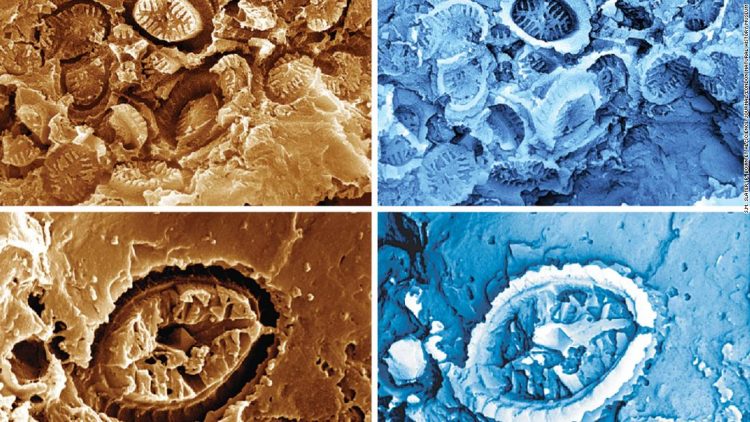Looking through a powerful microscope, researchers were stunned to see the impressions left by single-celled plankton, or fossilized nannoplankton, that lived millions of years ago — especially since they were analyzing something else.
“The discovery of the ghost fossils was a complete surprise,” said study author Sam Slater, researcher at the Swedish Museum of Natural History in Stockholm.
“We were actually studying fossil pollen from the same rocks. I had never seen this style of fossil preservation before, and the discovery was doubly surprising because the imprints were found in abundance from rocks where normal nannofossils are rare or missing entirely.”
As the researchers examined the pollen under a scanning electron microscope, they spied “tiny potholes” on the surface of the pollen, Slater said. When they zoomed in to see the potholes using magnifications of thousands of times, they observed complex structures.
Those structures were the impressions left by the exoskeletons of nannoplanktons called coccolithophores.
This microscopic plankton still exists today, and it supports marine food webs, provides oxygen and stores carbon within seafloor sediments. A coccolithophore surrounds its cell using a coccolith, or hard calcareous plate, which can fossilize in rocks.
Although tiny as individuals, coccolithophores can produce cloudlike blooms in the ocean that can be seen from space. And once they die, their exoskeletons drift down to rest on the seafloor. As they accumulate, the exoskeletons can turn into rocks like chalk.
The ghost fossils were created as seafloor sediment turned into rock. Layers of mud accumulating on the seafloor pressed the hard coccolith plates together with other organic matter, such as pollen and spores. As time passed, acidic water trapped within the rock spaces dissolved the coccoliths. All that was left was the impression in the stone they once made.
“The preservation of these ghost nannofossils is truly remarkable,” said study coauthor Paul Bown, a professor of micropaleontology at the University College London, in a statement.
“The ghost fossils are extremely small — their length is approximately five thousandths of a millimetre, 15 times narrower than the width of a human hair! — but the detail of the original plates is still perfectly visible, pressed into the surfaces of ancient organic matter, even though the plates themselves have dissolved away,” Bown said.
Filling a gap
Previous research noted a decline in these fossils during past global warming events that impacted the oceans, leading scientists to believe that the plankton were negatively affected by acidification in the ocean and climate change overall.
The ghost fossils tell a different story entirely, providing a record that shows coccolithophores were abundant in the ocean during three ocean warming events 94 million, 120 million and 183 million years ago, across the Jurassic and Cretaceous periods.
“Normally, palaeontologists only search for the fossil coccoliths themselves, and if they don’t find any then they often assume that these ancient plankton communities collapsed,” said study coauthor Vivi Vajda, professor at the Swedish Museum of Natural History, in a statement.
“These ghost fossils show us that sometimes the fossil record plays tricks on us and there are other ways that these calcareous nannoplankton may be preserved, which need to be taken into account when trying to understand responses to past climate change.”
The researchers were initially focused on the Toarcian Oceanic Anoxic Event, when volcanoes released increased carbon dioxide in the Southern Hemisphere and caused rapid global warming 183 million years ago during the Early Jurassic period.
Scientists have unearthed ghost fossils in the United Kingdom, Japan, Germany and New Zealand associated with this event, as well as specimens found in Sweden and Italy linked to warming ocean events 120 million years ago and 94 million years ago, respectively.
Understanding these ghost fossils can help researchers search for them in other fossil record gaps and better understand warming periods across Earth’s history.
Dead zones
The plankton were not only resilient in the face of rising temperatures — they actually diversified and thrived, and that may not have been a good thing for other species.
Big blooms of plankton aren’t a sign that an ecosystem is in trouble, but when a bloom dies and sinks to the seafloor, its decomposition uses oxygen and depletes it from the water, which can create areas where most species can’t survive.
“Rather than them being victims of these past warming events, our records indicate that the proliferation of plankton contributed to the expansion of marine dead zones — regions where seafloor oxygen levels were too low for most species to survive,” Slater said.
“These conditions, with expanding dead zones and plankton blooms, may become more widespread across our globally warming oceans,” he added.
Current global warming is occurring more quickly than these historical events, and Slater believes this study shows that scientists need a more nuanced approach to predicting how different species will respond as the global climate shifts, because not all of them will respond in the same way.

























